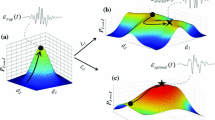Abstract
A large class of problems in optimally controlled quantum or classical molecular dynamics has multiple solutions for the control field amplitude. A denumerably infinite number of solutions may exist depending on the structure of the design cost functional. This fact has been recently proved with the aid of perturbation theory by considering the electric field as the perturbating agent. In carrying out this analysis, an eigenvalue (i.e., a spectral parameter) appears which gives the degree of deviation of the control objective from its desired value. In this work, we develop a scheme to construct upper and lower bounds for the field amplitude and spectral parameter for each member of the denumerably infinite set of control solutions. The bounds can be tightened if desired. The analysis here is primarily restricted to the weak field regime, although the bounds for the strong field nonlinear case are also presented.
Similar content being viewed by others
References
Aa.S. Sudbø, P.A. Schulz, E.R. Grant, Y.R. Shen and Y.T. Lee, J. Chem. Phys. 70 (1979) 912.
J.M. Jasinski, J.K. Frisch and C.B. Moore, Faraday Discuss. Chem. Soc. 75 (1983) 289.
G. Huang, T. Tarn and J. Clark, J. Math. Phys. 24 (1983) 2608.
A.H. Zewail and N. Bloembergen, J. Phys. Chem. 88 (1984) 5459.
D.J. Tannor and S.A. Rice, J. Chem. Phys. 83 (1985) 5013; Adv. Chem. Phys. 70 (1987);
S.A. Rice and D.J. Tannor, J. Chem. Soc. Faraday Trans. 82 (1986) 2423.
M. Shapiro and P. Brumer, J. Chem. Phys. 84 (1986) 4103; P. Brumer and M. Shapiro, Chem. Phys. Lett. 126 (1986) 54.
T.A. Holme and J.S. Hutchinson, Chem. Phys. Lett. 124 (1986) 181; J. Chem. Phys. 86 (1987) 42.
S. Shi, A. Woody and H. Rabitz, J. Chem. Phys. 88 (1988) 6870.
R. Kosloff, S. Rice, P. Gaspard, S. Tersigni and D. Tannor, Chem. Phys. 139 (1989) 201.
J. Manz, J. Chem. Phys. 91 (1989) 2190.
C. Chen and D.S. Elliot, Phys. Rev. Lett. 65 (1990) 1737.
J.G.B. Beumee and H. Rabitz, J. Math. Phys. 31 (1990) 1253.
S. Shi and H. Rabitz, J. Chem. Phys. 92 (1990) 364.
S. Shi and H. Rabitz, J. Chem. Phys. 92 (1990) 2927.
M. Dahleh, A.P. Peirce and H. Rabitz, Phys. Rev. A42 (1990) 1065.
C.D. Schwieters, J.G.B. Beumee and H. Rabitz, J. Opt. Soc. Amer. B7 (1990) 1736.
K. Yao, S. Shi and H. Rabitz, Chem. Phys. 150 (1990) 373.
S. Shi and H. Rabitz, Comp. Phys. Comm. 63 (1991) 71.
L. Shen and H. Rabitz, J. Phys. Chem. 95 (1991) 1047.
P. Gross, D. Neuhauser and H. Rabitz, J. Chem. Phys. 94 (1991) 1158.
H. Rabitz and S. Shi, Adv. Mol. Vibr. and Coll. Dyn. (ed. Joel Bowman) 1-A (1991) 187.
C.D. Schwieters and H. Rabitz, Phys. Rev. A44 (1991) 5224.
Y.S. Kim, H. Rabitz, A. A§kar and J.B. McManus, Phys. Rev. B44 (1991) 4892.
P. Gross, D. Neuhauser and H. Rabitz, J. Chem. Phys. 96 (1992) 2834.
M. Demiralp and H. Rabitz, Phys. Rev. A47 (1993) 809.
M. Demiralp and H. Rabitz, Phys. Rev. A47 (1993) 831.
M. Demiralp and H. Rabitz, J. Math. Chem. 16 (1994) 185.
J.L. Krause, R.M. Whitnell, K.R. Wilson. Y.J. Yan and S. Mukamel, J. Chem. Phys. 99 (1993) 277.
P.-O. Löwdin, in:Perturbation Theory and Its Application in Quantum Mechanics, ed. C. H. Wilcox (Wiley, New York, 1966).
A. Weinstein,Proc. Int. Conf, on Partial Differential Equations and Continuum Mechanics, No. 5, Univ. of Wisconsin, Madison, WI (1961).
B. Simon, Ann. Phys. 58 (1970) 76.
D. Grau, Int. J. Quant. Chem. 11 (1977) 931.
B. Simon, Int. J. Quant. Chem. 21 (1982) 3.
M. Demiralp, J. Math. Phys. 24 (1983) 101.
N. Ari and M. Demiralp, J. Math. Phys. 26 (1985) 1179.
G.A. Baker, Jr.,Essentials of Padé Approximants (Academic Press, New York, 1975).
Author information
Authors and Affiliations
Rights and permissions
About this article
Cite this article
Demiralp, M., Rabitz, H. Upper and lower bounds on the control field and the quality of achieved optimally controlled quantum molecular motion. J Math Chem 19, 337–352 (1996). https://doi.org/10.1007/BF01166724
Received:
Issue Date:
DOI: https://doi.org/10.1007/BF01166724




